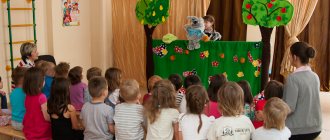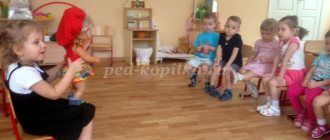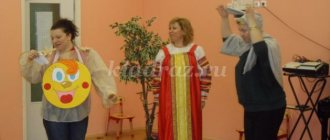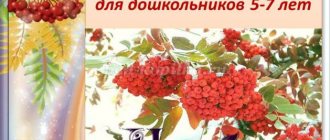Additional program for theater activities in kindergarten
Relevance of the program: One of the important problems common in our society among young people is indifference and lack of interests. They do not leave the computer, playing computer games day and night; they are not interested in anything else. In addition, young people have many complexes. They lack initiative, are not independent, are uncommunicative, constrained, and shy outside the virtual world. To overcome these problems, it is necessary to awaken some kind of interest in children at preschool age, develop independence, sociability, creativity, and help overcome shyness and stiffness. And the most fertile ground for this is the theater. In the theater, a child reveals all his capabilities; he feels not himself, but the hero he plays. Therefore, he loses his shyness, stiffness of movements, and all the complexes he has disappear. Direction of the program: This program is aimed at educating a creative person in the process of theatrical activity, developing his independence, activity, initiative in the process of mastering the skills of theatrical activity, as well as in other types of activities: communicative, artistic-aesthetic, cognitive. Showing your “I” in drawing, folk arts, in creating poems, inventing stories, expressing a stage image, in your vision of some kind of cognitive problem, but at the same time respect for the team, the ability to make compromises are important points this program. Novelty of the program: At preschool age, children are imitative, not independent, creativity is shown only slightly. Children repeat after the teacher and other children a story, a drawing, an image. This program is aimed at developing children's independence in artistic creativity and activity. I want to teach children to come up with their own games, fairy tales, stories, scenarios, and convey the stage image in their own way. Don’t copy someone else’s, but create and fantasize yourself. The program promotes the development of observation skills in children. Only by observing the behavior of animals and people can children understand the real feelings of those observed and convey these feelings to the viewer. This program covers, in addition to theater, other types of activities: educational, artistic and aesthetic, communicative. Children also show creativity in visual arts - they independently choose material for making various types of theaters, depict fairy tale heroes in their own way, conveying in the drawing their attitude towards him, how he imagines, sees this hero, conveys in the drawing episodes of the story invented by him. In communicative activities, children express their own opinions: “I believe,” “I believe.” It is important to teach a child to think, reflect, and not be afraid to express his own opinion, different from the opinions of others. Explanatory note Artistic and aesthetic education occupies one of the leading places in the content of the educational process of a preschool educational institution and is its priority direction. For the aesthetic development of a child’s personality, a variety of artistic activities are of great importance - visual, musical, artistic and speech, etc. An important task of aesthetic education is the formation in children of aesthetic interests, needs, aesthetic taste, as well as creative abilities . Theatrical activities provide a rich field for the aesthetic development of children, as well as the development of their creative abilities. In this regard, additional classes on theatrical activities have been introduced at the preschool educational institution, which are conducted by a teacher of additional education. Theater activities help develop the child’s interests and abilities; contribute to overall development; manifestation of curiosity, desire to learn new things, assimilation of new information and new ways of acting, development of associative thinking; perseverance, determination, manifestation of general intelligence, emotions when playing roles. In addition, theatrical activities require the child to be decisive, systematic in work, and hardworking, which contributes to the formation of strong-willed character traits. The child develops the ability to combine images, intuition, ingenuity and inventiveness, and the ability to improvise. Theatrical activities and frequent performances on stage in front of spectators contribute to the realization of the child’s creative powers and spiritual needs, emancipation and increased self-esteem. Alternating the functions of performer and spectator, which the child constantly takes on, helps him demonstrate to his comrades his position, skills, knowledge, imagination. Exercises for the development of speech, breathing and voice improve the child’s speech apparatus. Performing game tasks in the images of animals and characters from fairy tales helps to better master your body and realize the plastic possibilities of movements. Theatrical games and performances allow children to immerse themselves in the world of fantasy with great interest and ease, and teach them to notice and evaluate their own and others’ mistakes. Children become more relaxed and sociable; they learn to clearly formulate their thoughts and express them publicly, to feel and understand the world around them more subtly. Using the program allows you to stimulate children’s ability to imaginatively and freely perceive the world around them (people, cultural values, nature), which, developing in parallel with traditional rational perception, expands and enriches it. The child begins to feel that logic is not the only way to understand the world, that what is not always clear and ordinary can be beautiful. Having realized that there is no one truth for everyone, the child learns to respect other people’s opinions, be tolerant of different points of view, learns to transform the world, using fantasy, imagination, and communication with people around him. This program describes a training course in theatrical activities for preschool children aged 4-7 years (middle, high and preparatory groups). It was developed on the basis of the mandatory minimum content for theatrical activities for preschool educational institutions, taking into account the updating of content for various programs described in the literature. The goal of the program is to develop children's creative abilities through theatrical art, to develop children's interest in theatrical activities. Objectives • To create conditions for the development of creative activity of children participating in theatrical activities, as well as the gradual development by children of various types of creativity by age group. • Create conditions for joint theatrical activities between children and adults (staging joint performances with the participation of children, parents, preschool employees, organizing performances for older children in front of younger ones, etc.). • Teach children manipulation techniques in puppet theaters of various types. • Improve children's artistic skills in terms of experiencing and embodying the image, as well as their performing skills. • To familiarize children of all age groups with various types of theaters (puppet, drama, musical, children's theater, etc.). • Introduce children to theatrical culture, enrich their theatrical experience: children’s knowledge about the theater, its history, structure, theatrical professions, costumes, attributes, theatrical terminology. • To develop children's interest in theatrical and play activities. Objectives of the circle: 1. To develop intonation expressiveness of speech in children. 2. Develop the ability to sense the character of a literary work. 3. Develop expressiveness of gestures and facial expressions in children. 4. Develop the ability to distinguish between genres: nursery rhyme, fairy tale, story, highlight the positive and negative qualities of characters. 5. Develop the ability to evaluate the actions of heroes, situations, and a sense of humor. 6. Develop children’s ability to take part in dramatizations based on the plots of familiar works of art. 7. Encourage initiative and creativity. 8. Develop the ability to pronounce all sounds cleanly and clearly; coordinate words in sentences. 9. Cultivate a friendly attitude towards each other. Forms of work. 1. Theatrical games.
2. Classes in a theater group. 3. The teacher's stories about the theater. 4. Organization of performances. 5. Conversations and dialogues. 6. Production and repair of attributes and aids for performances. 7. Reading literature. 8. Design of an album about the theater. 9. Show performances. The program is compiled taking into account the implementation of interdisciplinary connections in the following sections: 1. Artistic and aesthetic: “Musical education”, where children learn to hear different emotional states in music and convey them with movements, gestures, facial expressions; listen to the music for the next performance, noting its varied content, which makes it possible to more fully appreciate and understand the character of the hero, his image. “Visual activity”, where children get acquainted with illustrations that are close in content to the plot of the play, learn to draw with different materials based on the plot of the play or its individual characters. “Rhythmics”, where children learn to convey the image of a hero, his character, and mood through dance movements. 2. “Speech development”, in which children develop clear, clear diction, work is being done on the development of the articulatory apparatus using tongue twisters, tongue twisters, and nursery rhymes. 3. “Educational”, where children get acquainted with literary works that will form the basis for the upcoming production of the play and other forms of organizing theatrical activities (classes in theatrical activities, theatrical games in other classes, holidays and entertainment, in everyday life, independent theatrical activities of children). 4. “Social - communicative”, where children get acquainted with the phenomena of social life, objects of the immediate environment, natural phenomena, which will serve as material included in the content of theatrical games and exercises. Interaction with parents and specialists: The work of the circle is more efficient and effective with the participation of specialists from preschool educational institutions: we resort to consultation with a teacher-psychologist to solve social and moral problems in children. Advice from a speech therapist helps improve the speech skills of preschoolers. Other teachers take part in holidays and entertainment in the role of characters. Parents provide assistance in making attributes and costumes for the holidays; participate as characters. Conversations with parents and their participation in the work of the circle help at home to consolidate the knowledge and skills acquired by children in classes and, thereby, achieve the results we want. Expected results: Children master expressive speech skills, rules of behavior, etiquette for communicating with peers and adults. Show interest and desire for theatrical art. They are able to convey various feelings using facial expressions, gestures, and intonation. They independently perform and convey images of fairy-tale characters. Children try to feel confident during performances. The subject-spatial developmental environment of the preschool educational institution was supplemented with different types of theaters, manuals, drawings, and card files of creative games. Close contact has been established with parents. SUGGESTED ABILITIES AND SKILLS 2nd junior group Able to act in a coordinated manner. They know how to relieve tension from individual muscle groups. Remember the given poses. Remember and describe the appearance of any child. Know 5-8 articulation exercises. They know how to exhale long while taking an imperceptible short breath. They can pronounce tongue twisters at different rates. They know how to pronounce tongue twisters with different intonations. They know how to build a simple dialogue. They can make sentences with given words. Middle group They are able to act in a coordinated manner. They know how to relieve tension from individual muscle groups. Remember the given poses. Remember and describe the appearance of any child. Know 5-8 articulation exercises. They know how to exhale long while taking an imperceptible short breath. They can pronounce tongue twisters at different rates. They know how to pronounce tongue twisters with different intonations. They know how to build a simple dialogue. They can make sentences with given words. Senior group Willingness to act in a coordinated manner, engaging simultaneously or sequentially. Be able to relieve tension from individual muscle groups. Remember the given poses. Remember and describe the appearance of any child. Know 5-8 articulation exercises. Be able to exhale long while inhaling imperceptibly, and do not interrupt your breathing in the middle of a sentence. Be able to pronounce tongue twisters at different rates, in a whisper and silently. Be able to pronounce the same phrase or tongue twister with different intonations. Be able to expressively read a dialogical poetic text by heart, pronouncing words correctly and clearly with the necessary intonations. Be able to form sentences with given words. Be able to build a simple dialogue. Be able to write sketches based on fairy tales. Preparatory group Be able to voluntarily tense and relax individual muscle groups. Orientate yourself in space, evenly positioning yourself around the site. Be able to move in a given rhythm, at the teacher’s signal, joining in pairs, threes, fours. Be able to collectively and individually transmit a given rhythm in a circle or chain. Be able to create plastic improvisations to music of a different nature. Be able to remember the mise-en-scène set by the director. Find a justification for a given pose. Perform simple physical actions freely and naturally on stage. Be able to compose an individual or group sketch on a given topic. Master a complex of articulation gymnastics. Be able to change the pitch and strength of the voice according to the teacher’s instructions. Be able to pronounce tongue twisters and poetic texts in motion and in different poses. Be able to pronounce a long phrase or poetic quatrain in one breath. Know and clearly pronounce 8-10 rapid-fire words at different rates. Be able to pronounce the same phrase or tongue twister with different intonations. Be able to read a poetic text by heart, pronouncing the words correctly and placing logical stresses. Be able to build a dialogue with a partner on a given topic. Be able to compose a sentence from 3-4 given words. Be able to choose a rhyme for a given word. Be able to write a story on behalf of the hero. Be able to compose a dialogue between fairy-tale characters. Know by heart 7-10 poems by Russian and foreign authors. Contents of the program. The content of the program includes eight main blocks presented in the table.
Let's list them. Block 1 – basics of puppeteering. Block 2 - basics of puppet theater. Unit 3 – basics of acting. Unit 4 – basic principles of dramatization. Block 5 – independent theatrical activity. Block 6 – theatrical ABC. Block 7 – holding holidays. Block 8 – leisure and entertainment. It should be noted that blocks 1, 5, 8 are implemented in one to two lessons per month; block 2 is implemented in two classes per month; blocks 3, 4 – in each lesson; block 6 – in thematic classes 2 times a year (three classes in October and March); block 1 is sold once a quarter. Download the program for theater activities in kindergarten
We recommend watching:
Theatrical activities in kindergarten Theater in the second junior group Do-it-yourself hat. Master class with step-by-step photos Script of a theatrical performance for children with disabilities (CP)
Similar articles:
Dramatization of Chukovsky's fairy tale The Fly Tsokotukha for children 5-7 years old
Dramatization of a fairy tale in the senior group “About the Little Mouse”
Theater performance in the senior group. Fox-sister and gray wolf
Theater quiz for the senior group
Game performance in kindergarten. Middle - senior group
Plan of theatrical activities in the preparatory group
Oksana Dedushchenkova
Plan of theatrical activities in the preparatory group
Plan of theatrical activities in the preparatory group
September
1. Sketches for the expressiveness of movements, for the expression of emotions: “Ill-mannered mouse”, “The mouse wants to play with friends”, “The mouse makes peace with friends”. Learn to find expressive means in facial expressions, gestures, intonations.
2. Recite poems with your hands: “Playing instruments”, “Haymaking”, “Centipede”. Learn to convey the content of poems using your hands.
3. Reading the work
K. Chukovsky “The Tsokotuha Fly.” Introduce the work of K. Chukovsky “Telephone”.
4. Dramatization of a fairy tale
K. Chukovsky “The Tsokotuha Fly.” Teach children to participate in a collective dramatization of a work in a timely manner; express the character’s state using facial expressions, voice, and intonation.
October
1. Pantomime tasks. Continue to develop a sustainable interest in theatrical play activities.
2. Meeting with familiar fairy tales. Fairy tale by Charles Perrault “Puss in Boots”
Help relieve psychological stress and muscle relaxation.
Remember a familiar fairy tale.
3. Table theater "Puss in Boots".
Learn to wield a doll, coordinate words with driving the doll.
4. Imagine. Games with tasks. Induce a joyful emotional mood in children; develop basic skills of facial expressions and gestures; teach children to pronounce phrases intonationally; develop imagination.
november
1. Staged improvisations.
Develop creativity.
2. Conversation about the theater. Didactic games “Meetings of heroes”, “Sound engineers”. Expand the vocabulary of theatrical terms.
3. Reading the fairy tale “The Bag of Apples”
Introduce children to the fairy tale “The Bag of Apples.” Develop imagination, facial expressions, gestures, plasticity.
4. Dramatization of the fairy tale “The Bag of Apples”
Learn to convey the character of the characters and their attitude towards people using facial expressions and intonation.
December
1. Theatrical game library “Funny Poems”.
Strengthen the ability to use theatrical puppets. Develop clear, expressive speech.
2. Quiz on Russian folk tales. Remember Russian folk tales.
3. Reading the Russian folk tale “The Wolf and the Fox.”
Continue to participate in theatrical activities, try to express yourself in different roles, and experience the joy of communication.
4. Puppet theater “Wolf and Fox”.
Help children experience a sense of satisfaction from the result of creative work.
January
1. Sketch “Kittens”, “Sun”.
Development of imagination, plasticity, facial expressions.
2. “Funny compositions.”
Encourage children to create simple stories with children as their heroes. Develop children's coherent speech (dialogical).
3. Telling the fairy tale “The Wolf and the Seven Little Goats” (table theater).
To foster children’s desire to tell and show fairy tales to other children.
4. Rhythmoplasty.
Develop flexibility and mobility of hands, fingers and arms.
February
1. The play “The Wolf and the Seven Little Goats.” Learn to wield a doll, coordinate words with driving the doll.
2. Reading the fairy tale by H. H. Andersen “Thumbelina” Introduce the children to the fairy tale. Learn to convey the character of the characters and their attitude towards people using facial expressions and intonation.
3. The fairy tale “Thumbelina”
(play).
Exercise the ability to convey the character of the characters and their attitude towards people using facial expressions and intonation.
4. Dramatization “Who is the most beautiful in the forest.” Develop creativity.
March
1. Role-playing game “Theater”
Teach children to pronounce a given phrase with a certain intonation in combination with gestures. Develop communication skills, learn to combine melodious speech with plastic movements.
2. Reading the fairy tale “The Fox and the Crane” Develop conversational speech. To reinforce in children the idea that there is a wise lesson in a fairy tale.
3. Puppet theater “Fox and Crane” Develop creativity, imagination and fantasy.
4. Reading the fairy tale “The Cat, the Rooster and the Fox.”
Remember the content of the fairy tale.
April
1. Rehearsal of the fairy tale “The Cat, the Rooster and the Fox.” .
Work on text and voice.
2. Rhythmoplasty.
Develop the ability to convey the character and mood of music in free improvisations.
3. Preparation for the play “The Cat, the Rooster and the Fox.”
Improve intonation expressiveness of speech.
4. Screening of the play “The Cat, the Rooster and the Fox.” Help children experience a sense of satisfaction from the result of creative work.
May
1. Reading the fairy tale “Zayushkina’s hut.”
Introduce the fairy tale “Zayushkina’s Hut” in poetic form.
2. Dramatization of “Zayushkina’s Hut.” Learn to convey the character of the characters using facial expressions and intonation.
3. Reading the fairy tale “Forest School”. Introduce a new fairy tale.
4. Dramatization of the fairy tale “Forest School”.
Develop creativity, learn to improvise.



